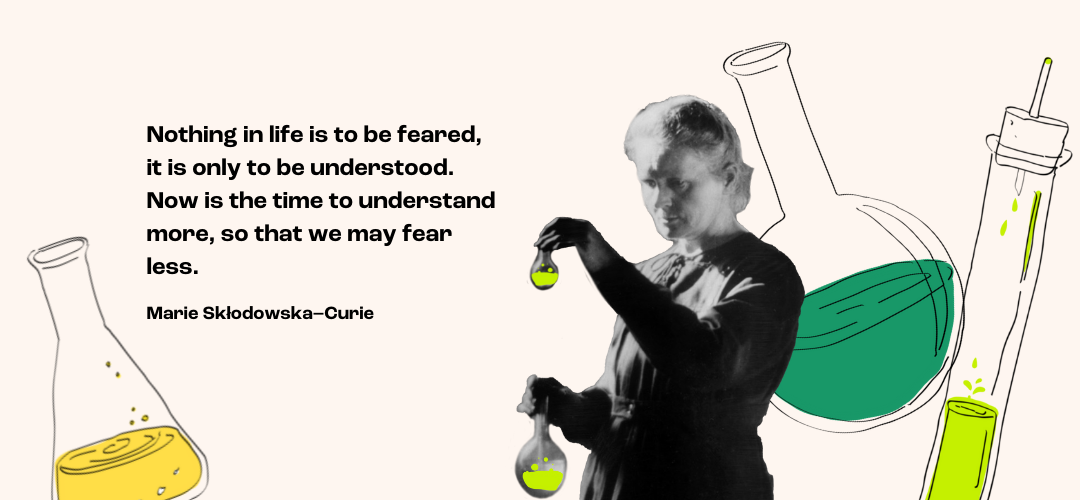
Marie Skłodowska–Curie (1867-1934) was a scientist who made crucial contributions to physics, chemistry, and medicine. She investigated the properties of radioactive elements and discovered new elements. Later, she realised that her discoveries could be used to treat cancer and volunteered helping injured soldiers using X-rays in the First World War (1).
An element is a substance where all the atoms have the same number of protons. They are the simplest possible chemical substance. There are currently 118 known elements, and combining the different elements in different ways makes the innumerable different materials that make up our universe (2)!
Skłodowska–Curie was born in Poland but completed most of her studying and research in France. Sadly, many academic institutions did not accept women, but she persevered and became the first woman to obtain a scientific doctorate in France (3).

Whilst researching in Paris, she met her future love: Pierre Curie. The two married with little ceremony; Marie insisted that she wear a dress she could also wear whilst working in the lab (4)! They began work investigating the properties of the newly discovered, mysteriously glowing, uranium. Marie called the energy emitted from the uranium radioactivity.
Armed just with an electrometer developed by Pierre and a converted shed, Marie found that the air around the sample conducted electricity. This could be used to measure the amount of radiation a sample was giving off, and she found that this only depended on the quantity of uranium present.
From here, she came up with the hypothesis (an educated guess, which can be proved or disproved with experiments) that the radioactivity comes directly from the atoms that make up uranium, an important step towards showing that atoms are made up of even smaller particles (4).
Atoms are the building blocks of all matter. They are named after the Greek word meaning 'uncuttable' because it used to be thought they were the smallest possible form of matter. We now know that atoms are made up of protons, neutrons and electrons, which themselves are made up of quarks. What, if anything, quarks are made of is a question physicists are currently working on! (5)
Their work led to Marie Skłodowska–Curie, Pierre Curie, and Henri Becquerel (who discovered the glow from uranium) being jointly awarded the 1903 Nobel Prize in physics. They decided not to retrieve the prize in-person due to ill-health and feeling that they were too busy! Later, in 1911, Marie received a Nobel Prize in Chemistry for discovering two new elements. This made her the first woman to win a Nobel prize, the first person to win two Nobel prizes, and to this day she is the only person to have received a Nobel prize in two different sciences (1).

Marie named the new elements she discovered polonium after her birth country and radium after the Sun. She discovered that when exposed to radon (the gas released by radium) diseased, cancerous cells were destroyed faster than healthy cells. The methods used for treating cancer developed from this are still used today and have saved many lives (6)!
This wasn’t the only way that Marie Skłodowska–Curie saved lives. During the First World War, she created X-ray vehicles for helping injured soldiers on the French battlefields. These units were nicknamed “petites Curies” - little Curies (4).
We now know that radiation can be very damaging to our bodies. Throughout her research, Marie noticed that she was getting increasingly weak, especially when she was collecting radon for hospitals to use. She died aged 66 due to the long-term exposure to the radiation she discovered (7).
Marie Skłodowska–Curie changed the world. Her research led to countless lives saved, a better understanding of what the world is made of, and countless practical applications of radioactivity. She did this all while struggling against the blockades society had placed in front of her due to her gender and difficulties with money. An inspiration for everyone in science!
Questions:
- Electricity travelling through the air seems a bit strange, but can you think of another time when this happens?
- There are lots of elements with interesting names. Consider einsteinium, californium, and neptunium. Can you guess what these were named after?
- What do you think uranium was named after? (Hint: it's a similar origin to neptunium)
- If you discovered a new element, what would you name it?
- Can you use the internet to find some uses of radioactivity?
by Ella Thomas.
References
- Nobel Prize Outreach AB 2022. “Marie Curie – Biographical - NobelPrize.org.” Nobel Prize, https://www.nobelprize.org/prizes/physics/1903/marie-curie/biographical/. Accessed 28 June 2022.
- “Definition of element - Chemistry Dictionary.” Chemicool Dictionary, https://www.chemicool.com/definition/element.html. Accessed 29 June 2022.
- Curiosity. “Marie Curie's Lab Notebooks Radioactive For Another 11000 Years.” Curiosity Database, 14 August 2021, https://curiositydb.com/marie-curies-lab-notebooks-radioactive-for-another-11000-years/. Accessed 28 June 2022.
- Pasachoff, Naomi. Marie Curie and the Science of Radioactivity. Oxford University Press, 1996. Accessed 28 June 2022.
- “atom | Etymology, origin and meaning of atom by etymonline.” Online Etymology Dictionary, https://www.etymonline.com/word/Atom. Accessed 28 June 2022.
- BBC. “History KS3: Marie Curie - The person who discovered radium and polonium.” BBC, https://www.bbc.co.uk/teach/class-clips-video/history-ks3-marie-curie-woman-who-discovered-radium-and-polonium/zjjxwty. Accessed 28 June 2022.
- Encyclopedia Britannica. “Marie Curie - Death of Pierre and second Nobel Prize.” Encyclopedia Britannica, https://www.britannica.com/biography/Marie-Curie/Death-of-Pierre-and-second-Nobel-Prize. Accessed 28 June 2022.
- “Lightning explained — Science Learning Hub.” Science Learning Hub, 29 April 2014, https://www.sciencelearn.org.nz/resources/239-lightning-explained. Accessed 28 June 2022.
- “Einsteinium.” Wikipedia, https://en.wikipedia.org/wiki/Einsteinium. Accessed 28 June 2022.
- “Californium.” Wikipedia, https://en.wikipedia.org/wiki/Californium. Accessed 28 June 2022.
- “Neptunium.” Wikipedia, https://en.wikipedia.org/wiki/Neptunium. Accessed 28 June 2022.
- “Uranium.” Wikipedia, https://en.wikipedia.org/wiki/Uranium#History. Accessed 28 June 2022.
- “Is radiation safe?” World Nuclear Association, https://www.world-nuclear.org/nuclear-essentials/is-radiation-safe.aspx#. Accessed 28 June 2022.
- “Uses of Radiation - Physics GCSE.” Revision Science, https://revisionscience.com/gcse-revision/physics/radioactivity/uses-radiation. Accessed 28 June 2022.

